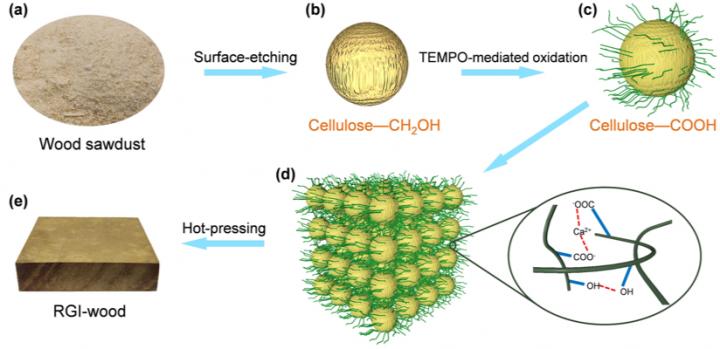
Credit: @SCIENCE CHINA PRESS
Since plastic was invented in the late 19th century, it was beginning to change human lives. The invention of plastic gives us a lightweight, strong and inexpensive material, which greatly facilitated daily life. Petroleum-based plastics play a critical role in human lives, but the flip side of the coin is, they possess a considerably increasing negative impact on the environment and human health. It’s unclear how long it will take for plastics to completely biodegrade into their constituent molecules. Estimates range from 450 years to never. Because plastics are hard to break down, waves and sunlight would have worn these non-degradable plastics into tiny bits, so-called microplastics. And those microplastics might be floating around the world’s oceans, sponging up toxins, waiting to be eaten by some hapless fish or oyster, and ultimately perhaps by one of us. In order to alleviate the hazards of plastic pollution, constructing sustainable materials for plastic substitute from all-green (i.e., 100 % bio-based) basic building blocks is a promising alternative option.
Nowadays, a team lead by Prof. Shu-Hong Yu from University of Science and Technology of China (USTC) report a high-performance sustainable regenerated isotropic wood (RGI-wood), constructed from surface nanocrystallized wood particles (SNWP) by efficient bottom-up strategy with micro/nanoscale structure design (Figure 1). Through surface nanocrystallization, a lot of cellulose nanofibers expand from the surface of wood sawdust and thus the properties of wood particles improved significantly. The obtained RGI-wood exceeds the limitation of the anisotropic, inconsistent mechanical properties, and inflammability of natural wood, making it a strong competitor to petroleum-based plastics. Mass production of large-sized RGI-wood can be achieved, overcoming the rareness of large-sized natural wood. Moreover, through this bottom-up strategy, a series of functional RGI-wood nanocomposites can also be prepared, which show great potential in diverse applications.
Based on the strong interaction between SNWP, high-performance RGI-wood can be obtained by the direct press. Through surface nanocrystallization of wood particles, RGI-wood exceeds the limitation of the anisotropic and inconsistent mechanical properties of natural wood with the isotropic flexural strength of ~170 MPa and flexural modulus of ~10 GPa. Comparing to natural wood, RGI-wood shows much higher flexural strength and modulus on both directions, due to the large surface area of cellulose nanofibers and long-range hydrogen bond interaction between SNWP. Moreover, RGI-wood also shows superior fracture toughness, ultimate compressive strength, hardness, impact resistance, dimensional stability, and fire retardancy to natural wood (Figure 2). As an all-green biopolymer material, RGI-wood is superior to petroleum-based plastics on mechanical properties, which allows RGI-wood to be a strong competitor to petroleum-based plastics on many application fields.
Moreover, because SNWP can perform as a great structural binder with the three-dimensional nano-network, this versatile bottom-up strategy holds promising of constructing a series of bulk functional composites. For example, by mixing SNWP with carbon nanotubes (CNTs) before pressing, the conductive smart RGI-wood can be prepared. The conductive smart RGI-wood has a lower percolation threshold and a lower exponent, indicating that CNTs can form a better conductive network than that of polymer/CNTs composite. Due to its high conductivity, this conductive smart RGI-wood shows excellent electromagnetic shielding performance (exceeds 90 dB in the X-band), which meets the requirements of shielding standards of precision electronic instruments. Additionally, this excellent electrical conductivity of conductive smart RGI-wood also allows it to self-heat through Joule heat at low voltages. A low heating voltage can effectively ensure the safety of self-heating devices while reducing energy consumption. Thus, the obtained conductive smart RGI-wood can be used as electromagnetic shielding materials and self-heating wallboard for smart buildings.
In short, this bottom-up strategy with micro/nanoscale structure design exceeds the limitation of the anisotropic, inconsistent mechanical properties and sizes of natural wood by introducing the surface nanocrystallization method of biomass particles. The micro/nanoscale structure design strategy can also be expanded to other biomass (e. g., leaf, rape straw, and grass, etc.), and a series of all-green sustainable structural materials can be made. With better mechanical properties than plastics, RGI-wood can become a strong competitor for petroleum-based plastics. Moreover, the RGI-wood and its nanocomposites show outstanding performance in various areas including mechanical properties, inflammability, smart materials, and building materials.
###
This research received funding from the National Natural Science Foundation of China, Innovative Research Groups of the National Natural Science Foundation of China, Key Research Program of Frontier Sciences, Chinese Academy of Sciences, the National Basic Research Program of China, and the Users with Excellence and Scientific Research Grant of Hefei Science Center of Chinese Academy of Sciences.
See the article:
Qing-Fang Guan, Zi-Meng Han, Huai-Bin Yang, Zhang-Chi Ling and Shu-Hong Yu
Regenerated isotropic wood
Natl Sci Rev; doi: 10.1093/nsr/nwaa230
https:/
Media Contact
Shu-Hong Yu
[email protected]
Related Journal Article
http://dx.




